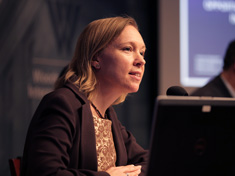-
Kathleen Mogelgaard: Four Steps to Better Link Climate Adaptation and Reproductive Health Strategies
March 28, 2014 By Paris Achenbach
Climate change vulnerability is closely tied to population dynamics, says Kathleen Mogelgaard in this week’s podcast. “We know that population size, composition and spatial distribution around the world is constantly changing, and that these changes do have implications for climate change exposure, sensitivity, and adaptive capacity – the three elements of vulnerability.”
Climate change vulnerability is closely tied to population dynamics, says Kathleen Mogelgaard in this week’s podcast. “We know that population size, composition and spatial distribution around the world is constantly changing, and that these changes do have implications for climate change exposure, sensitivity, and adaptive capacity – the three elements of vulnerability.”
And yet, despite this knowledge, alternative population scenarios are rarely considered in climate assessments. “We do know that things like fertility and population growth can be responsive to policy and programmatic interventions,” she says, and more than 233 million women worldwide currently lack access to family planning but want to delay or prevent pregnancy. Addressing that unmet need could make a major difference in the growth rates of many regions of the world, reducing climate vulnerability along the way.
“We do know that things like fertility and population growth can be responsive to policy and programmatic interventions”Mogelgaard outlines four ways the links between climate change adaptation and reproductive health strategies need to be strengthened: in adaptation planning frameworks, tools and training, program design, and the evidence base for these connections.
The creation of National Adaptation Programs of Action (NAPAs) was a major initiative by the UN Framework on Convention on Climate Change to create climate adaptation plans for the most vulnerable countries. Most of the plans, in fact, identified rapid population growth as something that exacerbates vulnerability. But when it came to the implementation phase, only a “handful of the NAPAs recognized that family planning and reproductive health services could be part of an adaptation strategy,” Mogelgaard says; fewer still made them a priority, and none were funded.
This was a missed opportunity, she says, but there is hope that the NAPA successors – the National Adaptation Plans – may be able to better incorporate reproductive health needs.
In the second area for strengthening, tools and training, Mogelgaard says it’s “part of a classical problem that we have, of people being in different sectors and not being able to talk across sectors.” She suggested there is a “deep need” for tools that can “help folks who are scientists, who are dealing with the physical aspects of climate change, understand some of the social dimensions related to population dynamics and reproductive health.”
In terms of program design, she says one promising approach is the population, health, and environment (PHE) model of development, which integrates community-based approaches to challenges related to population dynamics, access to health services, and environmental degradation.
PHE has an “explicit focus to address family planning among women in these communities,” she says, and is making progress in places like the Philippines, East Africa, and Malawi. She points out the Lake Chilwa Basin Climate Change Adaptation Program in particular, which incorporated family planning into their conservation project after discovering local women were struggling to participate due to lack of access to reproductive health services. “I would love to see more examples like that,” she says, “but to my knowledge I have not heard of other…explicit climate change adaptation programs that are incorporating lessons from PHE.”
For the last key area of integration, building the evidence base, Mogelgaard emphasizes the importance of publishing literature on these linkages in peer-reviewed journals. More exposure (and scrutiny) could “boost legitimacy, and better mainstream these ideas within the scientific community focused on climate change.”
“We don’t have a lot of evidence about how meeting family planning needs contributes directly to adaptive capacity. We can connect the dots…and yet the direct connection has not been very robustly documented yet in the published literature.”
Kathleen Mogelgaard spoke at the Wilson Center on March 11.
Friday podcasts are also available for download on iTunes.
Sources: The Lancet.
 A Publication of the Stimson Center.
A Publication of the Stimson Center.




